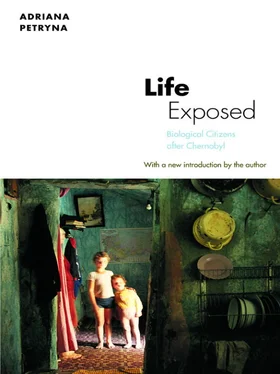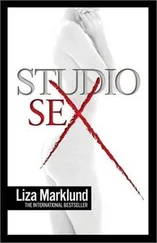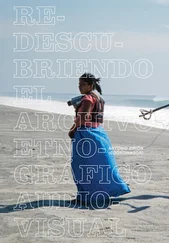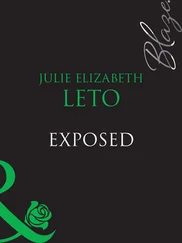Baysogolov, G. D., 41
Beck, Ulrich, 21
behavior: Pavlov’s experiments on, 131, 176–77, 237n.24; and sick role sociality, 89–90, 92–94, 235n.5; unmasked as socially conditioned, 27. See also psychological disorders
Belarus: contaminated territory/sufferers in, 4–5; human germline alteration study in, 10; rates of leukemia among cleanup workers in, 9
belief culture, 69–70, 73–74
BEVALAC, 56, 227n.35
Bhopal chemical disaster, 12, 223n.21
Bila-Skala (Ukraine town pseudonym):Chernobyl plume over, 74; Nazi extermination of Jews in, 67–68; New City of, 66–67; Old City of, 64–66, 228n.6; Strokats leave, 76
biodosimetric systems: to study Chernobyl accident, 55–56; U.S. research regarding, 52–53
bioethics, 20
biological adaptation, 162–63
biological citizenship: as collective/individual survival strategy, 218–19; conditions leading to role of, 118; economic benefits of, 85, 92–101, 105–7; emergence of, 5–6; marginalization of, 146, 203–4; polity building in postsocialism and, 6; research process granting Ivan, 181–90; responsibilities of healthy citizen vs. benefits of, 85; role of narratives and lineages in, 64; social institutions/personal vulnerabilities components of, 32–33; specific medical profile/relation to state of, 111–12; thyroid disorders and, 79–81. See also Anton; citizenship; Ukrainian political economy
biological measurements: disagreement among scientists regarding, 35–36; Soviet liability limited by, 35, 120–21
biological risk standards: cost-effectiveness models, 115–16, 117–18; social acceptability levels model of, 115–17; Soviet vs. Ukrainian approach to, 23–24, 100. See also environmental measurements
biomonitoring: FISH technique used for, 59, 129, 228n.38; introduced through collaboration, 52–53; stem cells used for, 59–61
biomonitors, 52
biopolitics, 12–13
biopower: biomedicine and social construction, 15; defining, 12–13; followed by Soviet/post-Soviet governments, 11, 12, 13–14; French (eighteenth century) use of, 13; linking of identity to, 14–15; relevance of to Chernobyl aftermath, 14–16. See also scientific knowledge
“bio-robots”, 30, 31, 50. See also Zone workers
“biosociality”, 14, 223n.20
biostrata (biological processes), 120
birth defects, 7–9, 10
birth rate statistics, 234n.21
birthright, 7
blat: access to resources through, 118; Chernobyl laws as instruments of, 25; described, 95; used to establish legal status, 29; used to gather resources for Clinic, 104. See also Ukraine economy
Blumenberg, Hans, 28
“bone marrow syndrome”, 40
Borneman, John, 24
Borovsky, Artem, 157–58, 163, 165, 166, 184–85, 186
“Brain Surveyor” experiment, 181–90
Brasova, Lena, 181, 184
British television documentary (1991, Thames Broadcasting, London), 30
Bromet, Evelyn, 186
Burawoy, Michael, 6
Bureau of Criminal Forensics study (1986), 124–25
“C” (Slavutych inhabitant), 154, 157
cancer cases: leukemia, 9, 10; skin, 111; thyroid, 1–2, 9, 10, 77–78, 229n.10
cancer death: caused by Chernobyl disaster, 55; studies of following Hiroshima/Nagasaki, 10
cancer risk: projections of excess Northern Hemisphere, 55; research on models of, 58–59; stem cell research on, 59–61
“catastrophe of Soviet biology”, 119–20
Ceanu, Angelina: new sociality and patient examination by, 167–70; prenatal brain damage research headed by, 164–65, 238n.36; research approach taken by, 159–60; research motivations of, 161–62
Center. See Radiation Research Center (Kyiv)
cesium-137 concentrations, 42 fig , 49 fig , 85
Champlin, Richard, 44
Cheliabinsk (Ural region), 39
Chernobyl accident patients: ARS combined with injuries of, 41; assessment of first airlifted, 40–41, 46; bone marrow transplants given to, 45, 46–47; division between original and later psychological, 48; medical personnel dispatched to care for, 225n.14; necrosed lung tissue of cleanup workers excluded as, 53; rehabilitation of, 47–48; sorted according to threshold dose, 41, 43; VvD diagnosis to filter claims by, 43–44, 123. See also disabled; patients; sufferers ( poterpili )
Chernobyl aftermath: act of believing dissimulation during, 69–70, 73–74; available data on toll during, 36–38; changes in doctor-patient relations during, 174–76; complex political/health experience of, 3; economic costs of, 4; escalation of death rates during, 146; humanitarian relief established during, 54–55; international cost-benefit analyses for cleanup during, 227n.29; political/social changes in Ukraine during, 15–16, 17–18, 100–101, 117, 215, 217–20; postsocialist civil society understood in context of, 25–27; relevance of biopower to, 14–16; as scientific experimental system, 25–27; Soviet vs. Ukrainian approach during, 11, 12, 13–14, 82, 99–100; systematizing probability of relations between population and, 164–65; tekhnohenna katastrofa (technogenic catastrophe) of, 3, 9–14; Ukraine nation building during, 20–25
Chernobyl explosion (1986): anthropological shock of, 3–4; association between Soviet collapse and, 4; biological effects/political interventions of, 49 fig ; compared to other disasters, 216–17; continued exposure of “sufferers” from, 2–3; difficulties in calculating human cost of, 117–18; emergency measures taken after, 36, 225n.2; events of, 1; initial report to IAEA by Soviets on, 225n.9; legacy to science from, 51–52; measuring plume following, 36–38; news passed through Zone of, 74–75; officially characterized as biological crisis, 2; official vs. local death toll of, 2, 13; plume from, 74, 80, 225nn.3 and 4; Soviet efforts to normalize/false accountability for, 38, 119, 120–21, 223n.21; volume of cesium-137 concentrations after, 42 fig , 85; Western offers to assess meteorological situation rejected, 38–39. See also Exclusion Zone
Chernobyl Expo, 146
Chernobyl Funds, 18, 54, 55, 104, 144
Chernobyl health effects: American team short-term interest in, 45–46; Chernobyl Fund monitoring of, 54; criticisms regarding improper management of, 117; data on symptoms/signs, and ill-defined states, 32–33 t ; long-term thyroid disorders, 79–81; neurological disorders and, 126–28, 233n.13, 236n.14; psychological disorders due to, 11, 48, 61, 235nn.12 and 15; “psychoneurological tendency” as, 160; research into long-term mental, 235n.12; suicide as, 147; VvD diagnosis of, 43–44, 123. See also disabled; health; illness; sufferers ( poterpili )
Chernobyl Ministry, 16
“Chernobyl Monies—For Those Who Are Eligible! For State Criminals—Jail” ( Kommunist 4), 143
Chernobyl nuclear reactor: establishment of, 22; Ukrainian post-Soviet administration of, 97–98
Chernobyl plume, 74, 80, 225n.3 and 4
“Chernobyl’s Legacy” ( Nature ), 51
“Chernobyl syndrome”, 127, 133, 136
Chernobyl tax, 99, 104
Chernobyl “tie” (document), 19, 111, 112, 129, 216. See also disability claims
children: Chernobyl tie and benefits for, 19; human germline alteration studies on Belarussian, 10; increased birth defects among, 7–9, 10; increase in thyroid cancer in, 10, 77–78, 134, 229n.10; inheritance of trauma by, 80–81, 186, 189, 206; in utero research on, 164–65, 184–90, 237n.34; narrative on poor health of, 88–89; radiation dose exposure of, 221n.4; research on abnormalities among Nagaskai/Hiroshima, 183–84; statistics on disease prevalence among Exclusion Zone, 184; thyroid operations on, 79; unequal medical treatment for, 134. See also Alina; Ivan; Little Halia
Читать дальше












